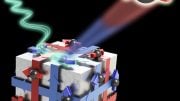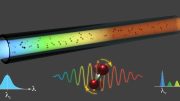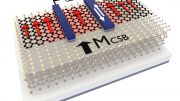
Ultrafast magnetic scattering on ferrimagnets enabled by a bright Yb-based soft x-ray source, which made the cover of Optica. Credit: Ella Maru Studio
INRS researchers and international partners have succeeded in looking at spin inside rare earth materials, using a tabletop ultrafast soft-X-ray microscope, for the first time.
Complex networks of systems are required for sharing real-time information. Switching the magnetization, or electron spin, of magnetic materials with ultra-short femtosecond laser pulses is a promising strategy for speeding up data storage devices. However, how the spin evolves in the nanoworld on extremely short time scales, such as one-millionth of one billionth of a second, has remained largely mysterious. In collaboration with TU Wien, Austria, the French national synchrotron facility (SOLEIL), and other international partners, Professor François Légaré’s team at the Institut national de la recherche scientifique (INRS) has made a significant breakthrough in this field. On April 6, 2022, their study was published in the journal Optica.
Until now, studies on the subject have relied heavily on limited-access large X-ray facilities such as free-electron lasers and synchrotrons. The team demonstrates, for the first time, a tabletop ultrafast soft X-ray microscope to spatiotemporally resolve the spin dynamics inside rare earth materials, which are promising for spintronic devices.
This new soft X-ray source based on a high-energy Ytterbium laser represents a significant step forward in the investigation of future energy-efficient and high-speed spintronic devices and could be used for many applications in physics, biology, and chemistry.
“Our approach provides a robust, cost-efficient, and energy-scalable elegant solution for many laboratories. It allows the study of ultrafast dynamics in nanoscale and mesoscale structures with both nanometer spatial and femtosecond temporal resolutions, as well as with the element specificity,” says Professor Andrius Baltuska, at TU Wien.
Bright X-ray pulses to watch the spin
With this bright source of X-ray photons, a series of snapshot images of the nanoscale rare earth magnetic structures have been recorded. They clearly expose the fast demagnetization process, and the results provide rich information on the magnetic properties that are as accurate as those obtained using large-scale X-ray facilities.
“Development of ultrafast tabletop X-ray sources is exciting for cutting-edge technological applications and modern fields of science. We are excited about our results, which could be helpful for future research for spintronics, as well as other potential fields,” says INRS postdoctoral researcher, Dr. Guangyu Fan.
“Rare earth systems are trending in the community because of their nanometer size, faster speed, and topologically protected stability. The X-ray source is very attractive for many studies on future spintronic devices composed of rare earth.” says Nicolas Jaouen, senior scientist at the French national synchrotron facility.
Professor Légaré emphasizes the collaborative work between experts in the development of state-of-the-art light sources and ultrafast dynamics in magnetic materials at the nanoscale. “Considering the quick emergence of high-power Ytterbium laser technology, this work represents huge potential for high-performance soft X-ray sources. This new generation of lasers, which will be available soon at the Advanced Laser Light Source (ALLS), will have many future applications for the fields of physics, chemistry, and even biology,” he says.
Reference: “Ultrafast magnetic scattering on ferrimagnets enabled by a bright Yb-based soft x-ray source” by G. Fan, K. Légaré, V. Cardin, X. Xie, R. Safaei, E. Kaksis, G. Andriukaitis, A. Pugžlys, B. E. Schmidt, J. P. Wolf, M. Hehn, G. Malinowski, B. Vodungbo, E. Jal, J. Lüning, N. Jaouen, G. Giovannetti, F. Calegari, Z. Tao, A. Baltuška, F. Légaré and T. Balčiūnas, 6 April 2022, Optica.
DOI: 10.1364/OPTICA.443440
The study received fincancial support from the Natural Sciences and Engineering Research Council of Canada, the Fonds de recherche du Québec – Nature et technologies (FRQNT) and PRIMA Québec, among others. The ALLS laboratory also benefits from an investment from the Canada Foundation for Innovation (CFI).
About INRS
INRS is a university dedicated exclusively to graduate level research and training. Since its creation in 1969, INRS has played an active role in Québec’s economic, social, and cultural development and is ranked first for research intensity in Québec. INRS is made up of four interdisciplinary research and training centres in Québec City, Montréal, Laval, and Varennes, with expertise in strategic sectors: Eau Terre Environnement, Énergie Matériaux Télécommunications, Urbanisation Culture Société, and Armand-Frappier Santé Biotechnologie. The INRS community includes more than 1,500 students, postdoctoral fellows, faculty members, and staff.









Be the first to comment on "Major Breakthrough for Efficient and High-Speed Spintronic Data Storage Devices"